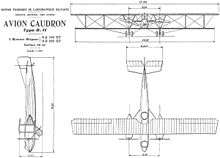Caudron R.11
The Caudron R.11, (mis-identified in Jane's 1919 as the Caudron R.II), was a French five-seat twin-engine bomber, reconnaissance and escort biplane developed and produced by Caudron during the First World War.
| R.11 | |
|---|---|
 | |
| Caudron R.11 at the Air Service, United States Army Air Service Production Center No. 2, Romorantin Aerodrome, France, 1918 | |
| Role | Bomber, Reconnaissance, Escort |
| Manufacturer | Caudron |
| Designer | Paul Deville |
| First flight | 1917 |
| Retired | July 1922 |
| Primary user | France |
| Number built | 370 |
Development
The R.11 was originally intended to fulfill the French Corps d'Armee reconnaissance category. Its design was similar to the Caudron R.4, but with a more pointed nose, two bracing bays outboard the engines rather than three, no nose-wheel, and a much larger tail. The engines were housed in streamlined nacelles just above the lower wing.
Operational history
The French army ordered 1000 R.11s. Production began in 1917, with the first aircraft completed late in that year. In February 1918 the first Escadrille (squadron) R.26 was equipped. The last escadrille to form before the Armistice (and abrupt end of production) was R.246, at which point 370 planes had been completed.
Variants
The Caudron R.12 was an experimental version of the R.11, with a larger engine. Development ended when the Caudron R.14 variant appeared in August 1918.
Operators
- American Expeditionary Force
Units using this aircraft
- Escadrille R.46
- Escadrille R.239
- Escadrille R.240
- Escadrille R.241
- Escadrille R.242
- Escadrille R.246
Specifications

Data from The Complete Book of Fighters [1][2]
General characteristics
- Crew: 3
- Length: 11.25 m (36 ft 11 in)
- Upper wingspan: 17.92 m (58 ft 10 in)
- Lower wingspan: 16.9 m (55 ft 5 in)
- Height: 2.7 m (8 ft 10 in)
- Wing area: 54.25 m2 (583.9 sq ft)
- Empty weight: 1,422 kg (3,135 lb)
- Gross weight: 2,167 kg (4,777 lb)
- Fuel capacity: 220 l (48 imp gal; 58 US gal)
- Powerplant: 2 × Hispano-Suiza 8Bba V-8 water-cooled piston engines, 160 kW (210 hp) each
- Propellers: 2-bladed wooden fixed pitch propellers
Performance
- Maximum speed: 190 km/h (120 mph, 100 kn) at sea level 167.3 km/h (90.3 kn; 104.0 mph) at 5,000 m (16,000 ft)
- Endurance: 3
- Service ceiling: 5,950 m (19,520 ft)
- Time to altitude: 2,000 m (6,600 ft) in 8minutes 6 seconds; 3,000 m (9,800 ft) in 14 minutes 18 seconds; 5,000 m (16,000 ft) in 39 minutes
Armament
- Guns: 5x 7.7 mm (0.30 in) Lewis machine guns
References
| Wikimedia Commons has media related to Caudron R.11. |
Notes
- Green and Swanborough 1994, p.111.
- Gey, C.G. (1969). Jane's all the World's Aircraft 1919 (Facsimile ed.). London: David & Charles (Publishers) Limited. p. 224a. ISBN 07153 4647 4.
Bibliography
- Donald, David, ed. (1997). The Encyclopedia of World Aircraft. Prospero Books. p. 235. ISBN 1-85605-375-X. Missing or empty
|title=(help) - Green, W; Swanborough, G (1994). The Complete Book of Fighters. New York: Smithmark. ISBN 0-8317-3939-8.